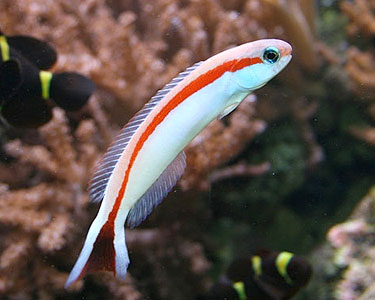Tilefish are Good Aquarium Fishes
In the article it is spoken about Tilefish are Good Aquarium Fishes.

Contents
Tilefish for the Fish-Only Tropical Saltwater Aquarium
Filefishes are great fishes for the tropical marine aquarium. While they are generally considered NOT reef compatible, in a fish only system, these unusual looking, leather-jackated (they are commonly called leatherjackets because of the texture of their skin) fishes prove both personable and intelligent.
Taxonomy
Tilefishes belong to the Order Tetraodontiformes, which includes the cowfishes, puffers and triggerfishes (all close relations). Of the two suborders of the Order Tetraodontiformes, filefishes belong to the suborder Tetraodontoidei, which includes, in addition to Monacanthidae (the subject of this article), the following families:
- Balistidae
- Diodontidae
- Molidae
- Ostraciidae
- Tetraodontidae
- Triodontidae
There are 95 described species in 31 genera of fishes in the Family Monacanthidae, which roughly translates from the Greek as “one thorn.” The filefishes are indigenous to the Atlantic, Indian and Pacific Oceans. While these fishes may be the “one thorns,” many, in fact, have two dorsal spines (although the second is usually considerably smaller). Filefish, generally-speaking, feed on small, bottom-dwelling (benthic) invertebrates, although some, like the longnosed filefish (Oxymonacanthus longirostris) are known corallivores, and a few feed primarily on zooplankton.
Best Tropical Marine Aquarium Filefishes
The most popular genera in the marine aquarium hobby are (alphabetically):
- Cantherhines
- Chaetodermis
- Oxymonacanthus
- Paraluteres
- Pervagor
Of these five genera, the genus Pervagor is hardily endorsed (click on the genus name in the above list for species recommendations). Cantherhines, Chaetodermis and Paraluteres are worth a look and some research. By all means, please steer clear of both species contained in the genus Oxymonacanthus as they are usually short-lived in captivity.
Husbandry: Habitat
Most are small fish, growing to about half a foot in length, but at least one filefish (Aluterus scriptus) exceeds three feet! Most commonly offered tropical species are fine in a tropical marine aquarium of 50 gallons or more, although a few (e.g. the mimic filefish, Paraluteres prionurus) can be kept in a tank as small as 30 gallons. Give all filefishes lots of live rock in which to hide and explore.
These are inquisitive fishes that are happiest when they can blend in with diverse surroundings. While they are not particularly touchy in terms of water quality, it is best to always keep your parameters high and (even more importantly) consistent.
Husbandry: Diet
While a few filefishes are obligate corallivores, most are opportunistic omnivores, and, as such, all must be considered NOT reef compatible. Feeding filefish in captivity is generally not difficult (with the MAJOR exception of the genus Oxymonacanthus). Most will accept a well-balanced captive diet including meaty marine flesh (e.g. raw table shrimp, clam, mussle, or scallop) and herbivorous preparations. All filefishes kept in fish only systems will appreciate periodic offerings of coralline-encrusted live rock, which will assist the animal in wearing down its dentition.
In Closing
While not as popular as tropical marine aquarium fishes as some of their close relations like the triggerfishes, filefishes do make excellent, interesting and attractive aquarium species in fish-only systems.



